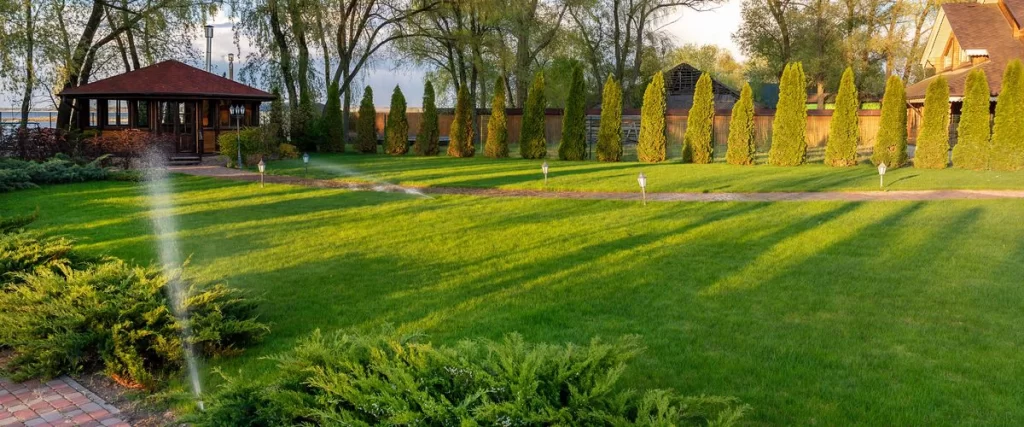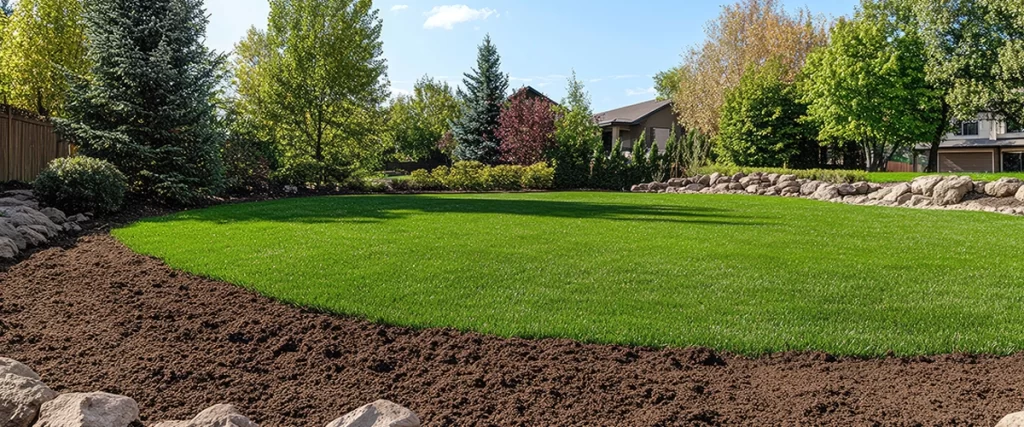A lush, green lawn doesn’t just appear overnight. It’s built through careful maintenance, patience, and timing. Overseeding is one of the most effective ways to refresh tired turf, fill in bare patches, and create a beautiful lawn that thrives through the seasons. But once the new grass starts growing, one question comes up again and again: when to mow after overseeding?
Mowing too early can pull new seedlings out of the soil and damage their delicate roots. Waiting too long can let the grass grow unevenly and block sunlight from reaching young sprouts. Finding the right balance makes all the difference between a patchy lawn and one that feels soft and healthy underfoot.
Let’s walk through the right timing, care steps, and tips for your first mow after overseeding so your lawn can grow thick, strong, and vibrant.

Understanding What Overseeding Does
Overseeding is the process of spreading new grass seed over an existing lawn. It gives old turf new life and helps maintain density. Homeowners often overseed in fall or spring, when temperatures are mild and moisture levels support good germination.
During this process, aeration is often done first. Aerating creates small holes in the soil, allowing air, water, and nutrients to reach deep into the root zone. It also gives the new seeds room to settle and grow without too much competition from existing grass.
When you combine aeration and overseeding, you’re setting up the lawn for better soil conditions, faster growth, and stronger roots. Still, the success of overseeding doesn’t just depend on planting, it depends heavily on how you care for the lawn afterward.
Why Timing Your First Mow Matters
Mowing is one of the most important steps in landscape maintenance, but it’s also one of the riskiest right after overseeding. The young grass blades may look ready to trim, but underneath, their roots are still developing. Cutting too soon can pull seedlings from the soil, leaving bare spots and slowing growth.
When grass is newly germinated, it focuses all its energy on establishing strong roots. Once that foundation is stable, the blades start to grow upward. Mowing too early interrupts that balance.
Waiting the right amount of time before mowing protects both the new growth and the surrounding turf, helping the lawn mature evenly.
When to Mow After Overseeding
The best time to start mowing after overseeding depends on grass type, weather, and growth rate, but generally, you should wait until the new grass reaches 3 to 4 inches in height.
For most lawns, this happens about three to four weeks after seeding under good conditions. Cooler weather or slower-growing varieties, like Kentucky bluegrass, may take longer. The key is to base your timing on the grass’s growth, not the calendar.
Here’s what to look for:
- The new seedlings have filled in the overseeded areas.
- The blades stand upright and have noticeable thickness.
- The ground feels firm when you walk on it not soft or muddy.
If the soil still feels loose or the grass easily pulls up, give it more time to establish.
Preparing for the First Mow
Before your first mow, take a few simple steps to make sure your lawn and mower are ready.
Check the Grass Height
Measure a few spots across your yard. The grass should consistently reach about 3 to 4 inches. Don’t rush if some areas are still shorter; wait until the majority of the lawn reaches that height.
Sharpen the Mower Blade
A dull blade tears grass rather than cutting it cleanly, which stresses new seedlings. A sharp blade slices cleanly through the foliage and helps the turf recover faster.
Mow on Dry Ground
Wet grass bends easily and can clump under the mower, making it harder to get an even cut. Wait until the lawn is dry from dew or rain before mowing.
Adjust the Cutting Height
For the first mow, set your mower to its highest setting. Remove only about one-third of the grass height at a time. Cutting more than that can shock young grass and slow root development.
Avoid Heavy Traffic
After mowing, give the lawn a few days to recover. Avoid walking over the area too much to prevent compacting the soil or damaging the new shoots.
After the First Mow
Once you’ve completed the first mow, continue regular care to encourage healthy, lasting growth.
Watering
Keep moisture consistent, especially during the first few weeks after mowing. Shallow roots still rely on regular water to stay hydrated. Water deeply but less frequently to encourage the roots to grow downward.
Fertilizer
Avoid adding fertilizer immediately after mowing. Wait about a week, then apply a balanced fertilizer to support continued growth. Too much nitrogen too soon can push foliage growth faster than roots can keep up.
Mowing Schedule
As the grass matures, gradually lower the mowing height. Don’t go shorter than 2.5 to 3 inches for most cool-season grasses. Keeping grass slightly taller helps shade the soil, retain moisture, and prevent weeds from spreading.
Keep the Blades Clean
New grass is sensitive. Clean mower blades after each use to prevent spreading fungus or disease across your lawn.
Common Mistakes to Avoid
Even small missteps can affect how well your overseeded lawn grows. Here are a few to keep in mind:
Mowing Too Early
This is the most common error. If you mow before the seedlings are established, you risk uprooting them. Always test a small area gently tug a few blades. If they resist and stay in place, the roots are likely ready.
Cutting Too Short
Never remove more than one-third of the grass height. Short mowing weakens the lawn, exposes roots to sun and heat, and encourages weeds to take hold.
Ignoring Soil Conditions
If the ground is soft, muddy, or uneven, the mower’s weight can leave tracks or compact the soil. Wait for firmer conditions to avoid damaging new turf.
Overwatering or Underwatering
Consistent moisture helps germination and early root development. Too much water can suffocate roots or lead to mold, while too little can dry out the seedlings.
Forgetting Aeration and Preparation
If the soil was compacted before overseeding, roots will struggle to grow deeply. Regular aeration helps keep the soil loose and oxygen-rich, giving the lawn the best chance to thrive.
The Role of Weather and Grass Type
Timing can shift depending on the weather and grass type.
- Cool-season grasses like Kentucky bluegrass, fescue, or ryegrass grow best in spring or fall when temperatures stay between 60 and 75°F.
- Warm-season grasses like Bermuda or zoysia thrive in late spring and early summer when soil temperatures rise.
Rain, sunlight, and soil temperature all affect germination. If the weather turns cold or dry, new seedlings may take longer to establish. Patience pays off wait until you see uniform, dense growth before scheduling your first mow.
Tips for Continued Lawn Health
Maintaining a strong, resilient lawn after overseeding isn’t just about one mow it’s about consistent care through the seasons.
- Keep mowing at the right height. Taller grass shades the soil and reduces evaporation.
- Feed your lawn strategically. Use a slow-release fertilizer in spring and early fall.
- Watch for pests. Young grass attracts insects and small animals looking for tender shoots.
- Rake lightly if needed. A light raking after mowing helps remove clippings and keeps the lawn breathing.
- Adjust to the season. During hot or dry periods, mow less often and water early in the morning to protect from evaporation.
Every yard has its own rhythm depending on sun exposure, soil type, and foot traffic. Learning how your turf responds helps you adjust your maintenance schedule for long-term success.
Patience Pays Off
It’s tempting to rush the first mow, especially when you see new blades covering the soil. But giving young grass time to develop strong roots is one of the best investments you can make for a lasting, healthy yard. A few extra days of waiting often means years of better turf performance.
If you’re not sure how to read your lawn’s growth, or if you want consistent results without the guesswork, professional landscape designer can help time each step correctly from overseeding to mowing to fertilizing.

Let Professionals Handle the Timing
Knowing when to mow after overseeding can make or break the success of your lawn. It takes patience, observation, and the right tools. Instead of tracking soil moisture, weather shifts, and seed height on your own, you can leave the timing to experts who do it every day.
At Easy Green Landscaping, we help homeowners across Lone Tree keep their lawns healthy and thriving year-round. Our team handles professional lawn maintenance with care that fits your yard’s unique conditions.
If you’d rather enjoy the results without all the monitoring and maintenance, call us at (303) 766-3304or Contact us. We’ll make sure your new grass grows strong and your lawn stays beautiful season after season.
